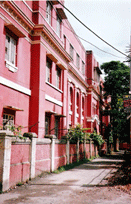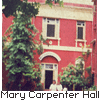| Brahmo Balika Shikshalaya |
 The Brahmo Balika Shikshalaya was founded on 16th May 1890. At that time much stress was laid on the spreading of emancipation of women and the spread of women's education. The Christian missionaries had set up a few schools in and around Calcutta. Later on enthusiasts like Raja Rammohun Roy, Debendranath Tagore, Ishwar Chandra Vidyasagar, Peary Charan Sarkar, Keshub Chandra Sen, Durgamohan Das, The Brahmo Balika Shikshalaya was founded on 16th May 1890. At that time much stress was laid on the spreading of emancipation of women and the spread of women's education. The Christian missionaries had set up a few schools in and around Calcutta. Later on enthusiasts like Raja Rammohun Roy, Debendranath Tagore, Ishwar Chandra Vidyasagar, Peary Charan Sarkar, Keshub Chandra Sen, Durgamohan Das,
| The School Motto |
 |
| The school motto is Sraddhya or respect, Tapasya or praying, and Sevaya or service. These three were formulated at the very initial stages to inspire the students. |
|
Dwarkanath Ganguli, Ananda Mohan Bose led to the opening of a number of schools for women. Amongst the foreign workers were Derozio and Bethune along with Miss Cook and Miss Ackroyd. Apart from Bethune school, Bangiya Mahila Vidyalaya, Victoria College were 50 such schools which were receiving grants from the government.
Founding and the initial years
 At around 1890, the Executive Committee of the Sadharan Brahmo Samaj decided that they needed to open a school for the young boys and girls. Ananda Mohan Bose At around 1890, the Executive Committee of the Sadharan Brahmo Samaj decided that they needed to open a school for the young boys and girls. Ananda Mohan Bose  mentioned that there was a need to set up an institution for true education, not that which is laid out in the pages of books. The children will sit on the carpet and read. Accordingly a school was opened on 16th May, 1890 at 13 Cornwallis Street, where 15 young boys and girls sat on a carpet and commenced their education. The monthly fee was Rs. 2 only. A hostel was formed soon after and in 1893, Brahmo Balika Shikshalaya became a boarding school. Dwarkanath Ganguli felt that formal education was not enough for women. If they were to be the mothers of the future citizens of India they also needed to learn home science, hygiene, medicine, cookery etc. mentioned that there was a need to set up an institution for true education, not that which is laid out in the pages of books. The children will sit on the carpet and read. Accordingly a school was opened on 16th May, 1890 at 13 Cornwallis Street, where 15 young boys and girls sat on a carpet and commenced their education. The monthly fee was Rs. 2 only. A hostel was formed soon after and in 1893, Brahmo Balika Shikshalaya became a boarding school. Dwarkanath Ganguli felt that formal education was not enough for women. If they were to be the mothers of the future citizens of India they also needed to learn home science, hygiene, medicine, cookery etc.
 In the initial years the fledgling In the initial years the fledgling  school was nurtured by Sivnath Shastri. He formalised the curriculum and the rules governing the institution. He was ably supported by Upendra Kishore RoyChowdhury, Ananda Mohan Bose, Dwarkanath Ganguli, Labanyaprabha Basu etc. With the help of Durgamohan Das, the school grew and in the next year the number of students increased to 63 and reached the entrance level in the third year. In 1894 - Sisir Kr. Bagchi and Pramada Das qualified for the entrance examination. This fame brought in more students but space and funds were the main constraints. school was nurtured by Sivnath Shastri. He formalised the curriculum and the rules governing the institution. He was ably supported by Upendra Kishore RoyChowdhury, Ananda Mohan Bose, Dwarkanath Ganguli, Labanyaprabha Basu etc. With the help of Durgamohan Das, the school grew and in the next year the number of students increased to 63 and reached the entrance level in the third year. In 1894 - Sisir Kr. Bagchi and Pramada Das qualified for the entrance examination. This fame brought in more students but space and funds were the main constraints.
When the governing body of the Sadharan Brahmo Samaj were debating whether to shift the school at some suburban location to reduce running costs, Dwarkanath Ganguli mortgaged his land and came up with the required funds. But his untimely death in 1898 led to paucity of funds again. At this time Kalinarayan Roy stepped  in with funds and the school shifted to a bigger house in 56 Mirzapur Street. The government also agreed to aid the school. in with funds and the school shifted to a bigger house in 56 Mirzapur Street. The government also agreed to aid the school.
New location
In 1903 a plot of land along with a house was purchased on Upper Circular Road. Mary Carpenter Trust of the Indian National Association and the British and Foreign Unitarian Association and the local people donated money to set up the first school building Mary Carpenter Hall.
Contribution of Lady Abala Bose
 Lady Abala Bose, wife of Acharya Jagadish Chandra Bose, was the secretary of the school from 1910 - 1936. Her organisational capacity along with her foresight and enthusiasm transformed the school into a top ranking institution at that time. In 1916 the Durgamohan Bhavan was constructed. In 1928 the old house was rebuilt into a girls hostel and renamed Ananda Mohan Bhavan. Bose wanted that the children should not only be good students but be properly disciplined in all spheres of life and have high moral values. With these in mind she taught the girls cooking and nursing, horticulture, music and arts, sculpture, cane and needlework. Stress was also laid on physical fitness - stick fighting, fighting with daggers, jujitsu, tennis, basketball etc. all formed part of the curriculum. Lady Abala Bose, wife of Acharya Jagadish Chandra Bose, was the secretary of the school from 1910 - 1936. Her organisational capacity along with her foresight and enthusiasm transformed the school into a top ranking institution at that time. In 1916 the Durgamohan Bhavan was constructed. In 1928 the old house was rebuilt into a girls hostel and renamed Ananda Mohan Bhavan. Bose wanted that the children should not only be good students but be properly disciplined in all spheres of life and have high moral values. With these in mind she taught the girls cooking and nursing, horticulture, music and arts, sculpture, cane and needlework. Stress was also laid on physical fitness - stick fighting, fighting with daggers, jujitsu, tennis, basketball etc. all formed part of the curriculum.  The students excelled in all disciplines and Ashrukana Sanyal and Roma Das stood first in 1922 and 1927 respectively. Bose also had the willing help of Miss Florence Saker as principal and tutors like Surendranath Banerjee and Pulin Das. The students excelled in all disciplines and Ashrukana Sanyal and Roma Das stood first in 1922 and 1927 respectively. Bose also had the willing help of Miss Florence Saker as principal and tutors like Surendranath Banerjee and Pulin Das.
In 1921 a free primary school was set up for the needy children and the teachers and students of the school helped to spread education amongst these children. Bose also implemented the Montessori method of education at the pre primary level and Nalini Raha was sent to Rome to be trained in this discipline. After her return the first Montessori trained school was set up in Calcutta.
The Montessori Section
 The Montessori Section was started in January 1930 and was the first Montessori The Montessori Section was started in January 1930 and was the first Montessori School in India. Miss Mayalata Shome and Miss Nalini Raha were sent abroad to get the Montessori training under the supervision of Madam Montessori. School in India. Miss Mayalata Shome and Miss Nalini Raha were sent abroad to get the Montessori training under the supervision of Madam Montessori.
Nalini Raha improvised the teaching methodology and made it as same as the developed country’s by using some indigenous teaching aids like inset, blocks, spindle & abacus for learning mathematics, paper cutting etc. She invented some unusual festival like “Doll Festival”, “Community Picnic” etc which were remarkable at that time.
The War years
During the Second World War - the school was shifted from Calcutta to Madhupur as the military occupied the school. The girls stayed in the hostel to continue with their studies.
Back to Calcutta
In 1945 the school returned back to its original home in Calcutta. Most of the furniture either had to be bought or repaired. Within a very short period the school started functioning as before. Also the school was fortunate to have Miss Saker as one of the principals.
The school has completed its centenary on 16th May 1990 and even now this school can boast as one of the premier educational institution for girls in Calcutta. Among its wings are the Montessori, Primary, Secondary and Higher Secondary sections.
 
|
|
|
|